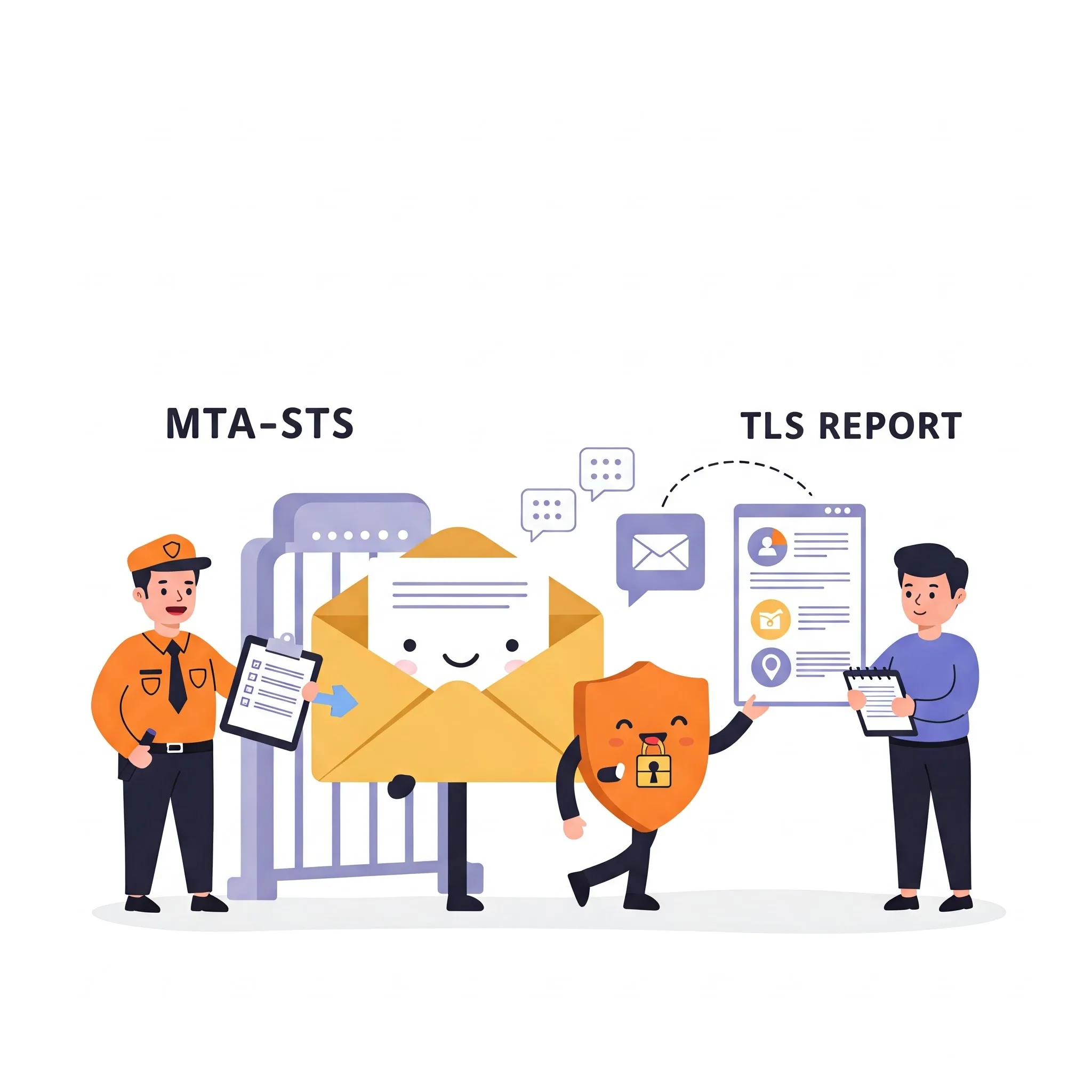In today’s digital landscape, email remains a critical communication tool, making its security paramount. While technologies like TLS (Transport Layer Security) encryption have long been the cornerstone of secure email transmission, two more recent mechanisms, TLS Reporting (TLS RPT) and Mail Transfer Agent Strict Transport Security (MTA-STS), significantly enhance this security by providing visibility and enforcement of TLS usage.
Let’s break down what these technologies are and why they matter.
TLS Reporting (TLS RPT): Shining a Light on Encryption Failures
Imagine sending an important email, assuming it’s securely encrypted in transit. But what if the receiving mail server encounters an issue and the connection falls back to unencrypted communication, or even fails entirely? Without a mechanism to notify you, you’d be none the wiser. This is where TLS Reporting (TLS RPT) comes in.
What it is:
TLS RPT is a mechanism that allows receiving mail servers to send reports back to the sending domain about the success or failure of TLS encryption attempts during email delivery. These reports provide valuable insights into potential issues preventing secure communication.
How it works:
- Publishing a Policy: The sending domain publishes a DNS TXT record under the _smtp._tls subdomain. This record specifies where receiving mail servers should send their TLS reports.
- Receiving Server Attempts Delivery: When a receiving mail server attempts to deliver an email to a domain with a TLS RPT policy, it tries to establish a TLS-encrypted connection.
- Generating Reports: If the TLS connection succeeds, fails, or falls back to an unencrypted connection, the receiving server generates a report detailing the outcome.
- Sending Reports: The receiving server sends this report to the email address(es) specified in the sending domain’s TLS RPT policy.
- Analyzing Reports: The sending domain can then analyze these reports to identify patterns, troubleshoot configuration issues on their own servers or those of their recipients, and gain visibility into potential man-in-the-middle attacks.
Why it’s important:
- Visibility into TLS Issues: TLS RPT provides crucial visibility into problems that might prevent email from being encrypted in transit.
- Troubleshooting and Configuration: It helps domain administrators identify and fix misconfigurations on their own servers or issues with receiving servers.
- Early Detection of Attacks: While not a direct preventative measure, consistent failures reported by TLS RPT could indicate potential interception attempts.
- Building Trust: By actively monitoring and ensuring TLS encryption, domain owners can build greater trust with their recipients.
MTA-STS: Enforcing Strict TLS Encryption
While TLS RPT provides valuable insights, Mail Transfer Agent Strict Transport Security (MTA-STS) takes email security a step further by allowing sending mail servers to enforce TLS encryption for domains that have opted in.
What it is:
MTA-STS is a standard that enables domain owners to declare that receiving mail servers must establish a TLS-encrypted connection when delivering emails to their domain. If a secure connection cannot be established, the sending server will refuse to deliver the email.
How it works:
- Publishing a Policy (DNS): The receiving domain publishes a DNS TXT record under the _mta-sts subdomain, indicating that it supports MTA-STS.
- Hosting a Policy File (HTTPS): The receiving domain also hosts an MTA-STS policy file at a well-known HTTPS URL (typically https://mta-sts.<yourdomain>/.well-known/mta-sts.txt). This file specifies the MTA-STS mode (either testing or enforce) and a unique policy ID.
- Sending Server Checks Policy: When a sending mail server attempts to deliver an email to a domain with an MTA-STS policy, it first queries the DNS for the _mta-sts record. If found, it then retrieves the policy file over HTTPS and validates its authenticity.
- Enforcing TLS:
- In enforce mode, if the sending server cannot establish a valid TLS connection with the receiving server (matching the criteria in the policy), it will refuse to deliver the email.
- In testing mode, failures will not prevent delivery, but will ideally be reported via TLS RPT, allowing the receiving domain to identify and fix issues before fully enforcing TLS.
- Policy Updates: The receiving domain can update its MTA-STS policy, and the policy_id in the file will change, signaling to sending servers that a new policy is in effect.
Why it’s important:
- Mandatory TLS Encryption: MTA-STS ensures that email delivery to participating domains always occurs over a secure, encrypted connection, eliminating the possibility of opportunistic downgrade attacks.
- Protection Against Downgrade Attacks: By requiring TLS, MTA-STS mitigates the risk of attackers intercepting communication and forcing a fallback to unencrypted protocols.
- Increased Email Security Posture: Implementing MTA-STS significantly strengthens the security of an email domain.
- Building Confidence: Recipients can have greater confidence that emails from domains implementing MTA-STS are protected during transit.
Working Together: A Powerful Combination
TLS RPT and MTA-STS are most effective when implemented together. MTA-STS enforces TLS encryption, while TLS RPT provides the necessary feedback loop to identify and resolve any issues that might prevent successful encrypted delivery.
In Conclusion:
TLS Reporting and MTA-STS are crucial technologies for enhancing email security in today’s threat landscape. By providing visibility into TLS usage and enabling the enforcement of secure connections, they significantly reduce the risk of eavesdropping and man-in-the-middle attacks. If you’re responsible for managing an email domain, understanding and implementing these standards is a vital step towards protecting your communications and building trust with your recipients.
Reach out to Technity to see how we can help you set up TLS RPT and MTA-STS for your domain today!
